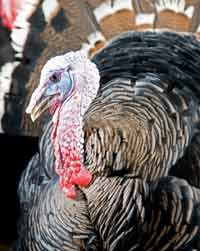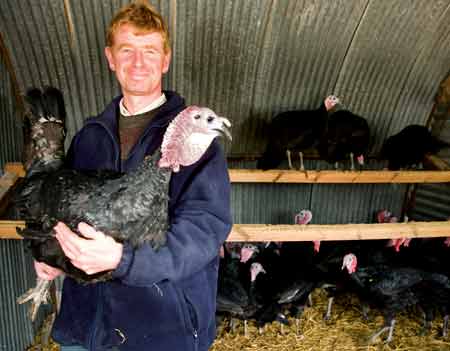Rare breed turkeys gaining in popularity this Christmas

Rare breed turkey is an expanding market for Christmas producers, as Jeremy Hunt found out
While millions of families sit down to a traditional roast turkey dinner this Christmas, a favoured few will be tucking into something for the more discerning palate. It will still be turkey, but nothing like the broad-breasted commercial strains most consumers are used to.
Flavoursome, moist-meated rarities with evocative names like the Bourbon Red and Norfolk Bronze are finding their way on to an increasing number of festive tables as consumers seek out new and unusual Christmas poultry.
A handful of enthusiasts has been responsible for maintaining small flocks of these intriguing birds. British United Turkeys (now part of the Aviagen Group) kept a nucleus of stock of several rare breeds as part of their hybrid development programme for many years, but this stock was dispersed some time ago with the birds finding their way into the hands of private breeders following support from the Rare Breeds Survival Trust.
While most rare turkey keepers are keen “fanciers” with their fascination fired primarily by the birds’ appearance, surplus stock has always found a ready market among those who relished the taste of something different at Christmas. But with the explosion of consumer interest in rare breeds of livestock in recent years, poultry keepers who have remained loyal to the minority turkey breeds have found themselves with a very saleable commodity on their hands – and one that’s able to command a price of up to £10/kg.
One of the UK’s leading experts on rare breed turkeys is Janice Houghton-Wallace – secretary of the Turkey Club UK. She keeps a host of rare breed turkeys at her home in south-west Scotland and says more people are discovering the delights of them as table birds.
“There are several turkey breeds, but most consumers just think a turkey is a turkey – or they may know there are black ones and white ones. There aren’t a lot of breeders in the UK with large numbers of surplus birds to spare for the Christmas trade, but those who have started to supply this market are finding the real foodies adore the taste and flavor,” she says.
One of the largest producers of rare breed turkeys is Norfolk farmer James Graham – a true supporter of rare breeds of livestock, whose dressed birds have found their way on to the shelves of Fortnum & Mason. They are also recommended in Delia Smith’s Christmas Cook Book.
Mr Graham’s business – Peele’s Turkeys – is at Thuxton, near Norwich where he runs a flock of well over 2000 birds representing several of the rare breeds, such as the Lavender, Norfolk Black, Bronze, Bourbon Red and Nebraskan. Although most are run as separate flocks according to breed, a degree of cross-breeding does take place and still produces excellent table birds.
“We started to get some interest from local butchers about seven years ago when we offered them a few surplus birds from our rare breed turkeys and things have developed from there,” says Mr Graham.
Now continuing to supply local butchers – as well as selling poults to other producers for finishing – he says consumers have come to understand that rare breed turkeys have a different carcass shape to the ones they are more used to seeing in supermarkets.
 |
|---|
| James Graham supplies dressed birds to Fortnum & Mason. |
“The rare breeds may not present such a pleasing picture when they come out of the oven because they are high-breasted. But any concerns a first-time buyer may have are soon allayed once they’ve tasted the meat. It’s absolutely delicious and is extremely moist and full of flavour.”
He adds: “If you take the Lavender for instance. This breed produces a high breasted table bird weighing around 12lb for hens and 14-18lb for stags. When you come to pluck them you find they also have a very heavy white down under the feather so they do differ from commercial birds in many ways. But the real pay-off is when you taste that first mouthful of meat.
“These birds carry some fat under the flesh and it’s that which provides an ideal natural basting of the bird as it cooks. The result is a very moist meat with a distinct flavour.”
Mr Graham’s flock is split into two management regimes – on range and in pens. Broodiness is a tendency with many of the rare breeds, even though their eggs are removed each day during the springtime laying season. Growing poults are fed a home-grown cereal feed with a low protein level of around 15.5%.
“They are slow growing and that’s another reason why they carry more flavour than the faster growing commercial birds. We feed a low protein diet to compliment their slower development because they are seven to eight months old before they are ready – that’s almost twice the age of many commercial birds at slaughter.”
Malcolm Thompson of Gunnislake, Cornwall, has been rearing rare breed turkeys for 12 years and keeps Buffs and Bourbon Reds. His birds are categorised as being of the medium to heavy strains and produce “very acceptable” table birds at around 10 months old.
“I think there could be a very good future for rare breed turkeys to meet a niche food market among consumers who really want to savour real turkey meat.
“Breeds like the Bourbon Red scrub up well – they are truly undervalued,” says Mr Thompson who sells surplus breeding birds for around £45 each at six-months old.
Want to know more? |
|---|
| The Turkey Club UK – www.turkeyclub.org.uk Peele’s Turkeys – (01362 850 237) British United Turkeys – www.aviagen.com Rare Breeds Survival Trust – www.rbst.org.uk |
The Moorhouse family from Meiford in Mid-Wales are enthusiastic rare breed turkey keepers running several breeds including Bronze, Blue and Slate, Bourbon Red, Nebraskan and Buff. They point out that they are “very active” birds and their behaviour must be taken into account by anyone embarking on a new venture.
“Keeping them on free range is the ideal way to enable these slow-growing birds to mature but they can be flighty and are extremely active. Some of these birds have a six-foot wing span so it pays to know what you are dealing with from the outset. These are not typical, heavyweight turkeys,” she says.
Michael Sumner is confident that there’s an expanding market for rare breed turkeys as consumers look for new tastes from pure breeds of livestock.
He keeps Buff and Slate turkeys at his home at Horncastle, Lincolnshire, and says that although birds are slow to mature, it’s the fat development during this longer growth stage that enhances the flavour of the flesh.
“Some of the breeds are more active than others but the Buff is a very relaxed and quiet bird and will grow well if properly fed and managed. It can produce dressed stags weighing up to 18lb, with hens reaching around 12lb. There’s no comparison with the taste compared with commercial birds that are slaughtered at 13 weeks old.”
View more pictures of James Graham’s rare breed turkeys on the new Poultry World picture gallery.
